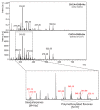Direct Analyses of Secondary Metabolites by Mass Spectrometry Imaging (MSI) from Sunflower (Helianthus annuus L.) Trichomes
- PMID: 28489027
- PMCID: PMC6154581
- DOI: 10.3390/molecules22050774
Direct Analyses of Secondary Metabolites by Mass Spectrometry Imaging (MSI) from Sunflower (Helianthus annuus L.) Trichomes
Abstract
Helianthus annuus (sunflower) displays non-glandular trichomes (NGT), capitate glandular trichomes (CGT), and linear glandular trichomes (LGT), which reveal different chemical compositions and locations in different plant tissues. With matrix-assisted laser desorption/ionization (MALDI) and laser desorption/ionization (LDI) mass spectrometry imaging (MSI) techniques, efficient methods were developed to analyze the tissue distribution of secondary metabolites (flavonoids and sesquiterpenes) and proteins inside of trichomes. Herein, we analyzed sesquiterpene lactones, present in CGT, from leaf transversal sections using the matrix 2,5-dihydroxybenzoic acid (DHB) and α-cyano-4-hydroxycinnamic acid (CHCA) (mixture 1:1) with sodium ions added to increase the ionization in positive ion mode. The results observed for sesquiterpenes and polymethoxylated flavones from LGT were similar. However, upon desiccation, LGT changed their shape in the ionization source, complicating analyses by MSI mainly after matrix application. An alternative method could be applied to LGT regions by employing LDI (without matrix) in negative ion mode. The polymethoxylated flavones were easily ionized by LDI, producing images with higher resolution, but the sesquiterpenes were not observed in spectra. Thus, the application and viability of MALDI imaging for the analyses of protein and secondary metabolites inside trichomes were confirmed, highlighting the importance of optimization parameters.
Keywords: Helianthus; LDI; MALDI; imaging; mass spectrometry; polymethoxylated flavonoids; sesquiterpene lactones; sesquiterpenes; trichome.
Conflict of interest statement
The authors have no conflict of interest to declare.
Figures








References
-
- Werker E. Trichome diversity and development. Adv. Bot. Res. 2000;31:1–30.
MeSH terms
Substances
LinkOut - more resources
Full Text Sources
Other Literature Sources

